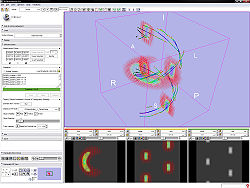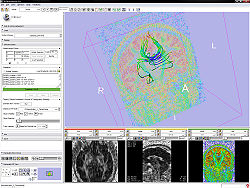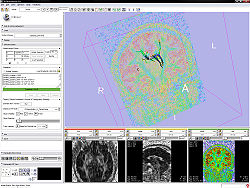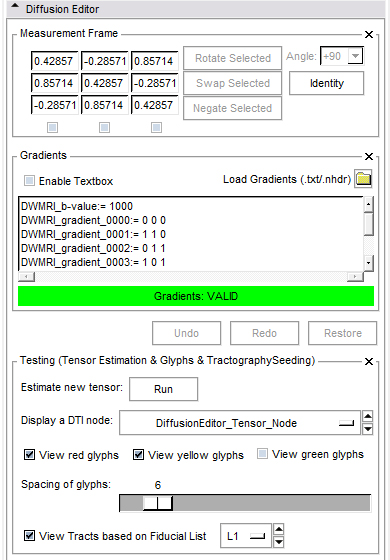Modules:Volumes:Diffusion Editor-Documentation
Return to Slicer Documentation
Diffusion Editor
General Information
Module Type & Category
Type: Interactive
Category: Diffusion Imaging
Authors, Collaborators & Contact
- Author: Kerstin Kessel
- Supervisor: Steve Pieper, Ron Kikinis
Module Description
The Diffusion Editor is a 3D Slicer module that allows modifing parameters (gradients, bvalues, measurement frame) of DWI data and provides a quick way to
The goal of this project is to add a Diffusion Editor for DWI data in the Volumes module of Slicer3. As the documentation of gradients in dicom data is not standardized, MRI scanners handle gradients/bValues differently. Because of that there is a big need to add/modify gradients manually.
The current version of the Diffusion Editor can be used to:
- For DWI
- edit gradients manually or load existing gradients from file (.txt or .nhdr).
- edit the measurement frame manually or simply rotate/swap/negate columns by selecting them.
- test the parameters by estimating a tensor and displaying glyphs and tracts.
- For DTI
- edit the measurement frame as described above.
- test by displaying glyphs and tracts.
Usage
Examples & Tutorials
TODO: Tutorials; add ExampleData
- Download example data: DiffusionEditor_ExampleData.zip
- Tutorials
| title | used data | short description |
|---|---|---|
| Load | ___ | Load a DWI dicom data set in Slicer. |
| Measurement frame | ___ | Change the measurement frame by rotating, swapping, negating or changing to identity. |
| Gradients | ___ | Change gradients manually or load them from a file. |
| Testing | ___ | Run tensor estimation and show glyphs and tracts;
Run second estimation with 90°rotation and switch between both tensors and see the impact of that change. |
Quick Tour of Features and Use
- Measurement frame:
- The determinant of the measurement frame has to be 1. This is checked by the editor.
- Negate: Select the columns you want to negate.
- Swap: Select two columns you want to swap.
- Rotate: Select one column you want to rotate by an angle you can choose from a given set of values or set yourself.
- Identity: Set the measurement frame to the identity matrix.
- Set your own values.
- Gradients frame:
- If the active volume is a DWI the editor will put the gradients in the text field; otherwise this frame is disabled.
- You can copy/paste your own gradients in the text field or change them manually.
- You can load gradients from a text file or .nhdr file. For the .txt file the format of gradients is easy, it can contain only values ( see example data ).
- Undo/Redo/Restore:
- Undo: Undo the last change of measurement/gradient values.
- Redo: Redo the last change of measurement/gradient values.
- Restore: All parameters are restored to original.
NOTE: You lose all previous changes when a new active volume is loaded or selected.
- Testing frame:
- Run tensor estimation. The new tensor node shows up in the DTI selector.
- Select a DTI node from the current mrml scene and
- view glyphs. Select the planes on which you want to see glyphs and adjust the spacing.
- view tracts with Tractography Fiducial Seeding. Add some fiducials and choose the fiducial list in the selector.
Development
Status / Implementation Progress
The editor is now successfully integrated in the Volumes module of the trunk version of Slicer3.
- measurement frame (gui/load/change/save): 100%
- gradients (gui/load/change/save): 100%
- undo/redo/restore mechanism: 100%
- testing frame: 90%
- tensor estimation with existing clm: 100%
- glyphs view in all three planes with the possibility to change spacing: 90%
- tractography fiducial seeding: 100%
- tests: ctest, ... 50%
- documentation, tutorials (videos): 40%
- writing master thesis: 5% :-)
Known bugs
Follow this link to the Slicer3 bug tracker to see known bugs, or to report a new one. Please select the usability issue category when browsing or contributing:
http://na-mic.org/Mantis/main_page.php
Source code & documentation
Source code is available here:
http://www.na-mic.org/ViewVC/index.cgi/trunk/Modules/Volumes/vtkSlicerDiffusionEditorWidget.cxx http://www.na-mic.org/ViewVC/index.cgi/trunk/Modules/Volumes/vtkSlicerDiffusionEditorWidget.h
http://www.na-mic.org/ViewVC/index.cgi/trunk/Modules/Volumes/vtkSlicerDiffusionEditorLogic.cxx http://www.na-mic.org/ViewVC/index.cgi/trunk/Modules/Volumes/vtkSlicerDiffusionEditorLogic.h
http://www.na-mic.org/ViewVC/index.cgi/trunk/Modules/Volumes/vtkSlicerMeasurementFrameWidget.cxx http://www.na-mic.org/ViewVC/index.cgi/trunk/Modules/Volumes/vtkSlicerMeasurementFrameWidget.h
http://www.na-mic.org/ViewVC/index.cgi/trunk/Modules/Volumes/vtkSlicerGradientsWidget.cxx http://www.na-mic.org/ViewVC/index.cgi/trunk/Modules/Volumes/vtkSlicerGradientsWidget.h
http://www.na-mic.org/ViewVC/index.cgi/trunk/Modules/Volumes/vtkSlicerDWITestingWidget.cxx http://www.na-mic.org/ViewVC/index.cgi/trunk/Modules/Volumes/vtkSlicerDWITestingWidget.h
Links to documentation generated by doxygen:
http://www.na-mic.org/Slicer/Documentation/Slicer3/html/
More Information
Acknowledgement
This research project was part of a Master thesis (Diplomarbeit) in cooperation of the faculty of Medical Informatics, University of Heidelberg/Germany and the Surgical Planning Lab. It was supported by a grant of the Lions Club Heilbronn/Franken.
References
TODO: add link to thesis, papers...
Nrrd format: http://wiki.na-mic.org/Wiki/index.php/NAMIC_Wiki:DTI:Nrrd_format
DTMRI: http://wiki.na-mic.org/Wiki/index.php/Slicer3:DTMRI
DICOM for DWI and DTI : http://wiki.na-mic.org/Wiki/index.php/NAMIC_Wiki:DTI:DICOM_for_DWI_and_DTI



